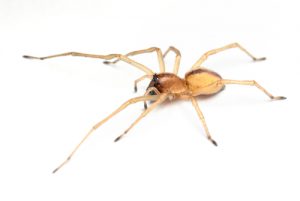Attack of the Yellow Sac Spider
By Chris Williams on March 7, 2012.
Yellow sac spiders are the common source of spider bites in homes. These small yellow to greenish spiders are implicated in most domestic spider bites, especially if no spider is found. In the North East, Black Widow and Brown recluse spiders are uncommon, but may rarely be encountered. Both the Black Widow and Brown Recluse spiders are web builders, and relatively sedentary, biting only when disturbed. Sac spiders are hunting spiders that scramble around at night in search of prey, they do not build webs. As they hunt with the long first pair of legs out stretched, they are able to grab prey and inject venom quickly upon contact. With fangs pointed almost forward it is easy to be bitten by sac spiders.
 Yellow sac spiders frequent shrubs, trees, leaf litter, debris piles, and other similar habitats. In their nocturnal quest for prey they may enter homes through poorly fitting screens, under doors, and through any small openings in foundations or rooflines. Larval spiders are tiny and may simply pass through screens. In summer months sac spiders are mainly hunting outside, moving all over bushes and exterior siding. As winter approaches and temperatures fall, sac spiders may enter homes to keep warm and find prey. Feeding on small insects, sac spiders may become quite numerous inside with adequate food resources.
Yellow sac spiders frequent shrubs, trees, leaf litter, debris piles, and other similar habitats. In their nocturnal quest for prey they may enter homes through poorly fitting screens, under doors, and through any small openings in foundations or rooflines. Larval spiders are tiny and may simply pass through screens. In summer months sac spiders are mainly hunting outside, moving all over bushes and exterior siding. As winter approaches and temperatures fall, sac spiders may enter homes to keep warm and find prey. Feeding on small insects, sac spiders may become quite numerous inside with adequate food resources.
Sac spiders get their name from the small silken sac they create to spend the daylight hours. The sacs may be located in leaves, under logs or boards, or in homes behind pictures, in cracks, and typically at the junction of walls and ceilings. As they hunt they also create “drop lines”, or rescue lines as a means of escape. These almost invisible threads are used in case the spider falls or jumps off a surface, allowing them to get back safely. These drop lines may collect dust and form cob webs in corners if not removed. Where there is lots of sac spider activity, there may be numerous sleeping sacs(used once), and drop lines all over the walls and ceiling.
Female sac spiders lay around 35-40 eggs, in small white egg sacs after mating. Surrounded by a loose covering of silk and placed in discrete locations. After hatching several larval stages take place. Larval spiders leave the egg site, and disperse in search of prey.
When inspecting for sac spiders, a flashlight will aid in seeing the small silken sacs, drop lines and egg cases. Shine the light along upper corners, behind curtains, wall hangings, and furniture. Drop lines can be made visible by shining the beam parallel to walls, creating a faint shadow when present. New sacs and drop lines will be free of dust, indicating recent activity.
Control of sac spiders starts with the vacuum. A crack and crevice attachment will suck up sac spiders, old sacs, drop lines and egg cases. After sucking up live spiders it is best to discard the vacuum bag to prevent escape, although spiders are usually killed during vacuuming. Next, check to see that all screens are properly fitting, doors have appropriate weather stripping, and obvious cracks and entryways are sealed tight. Then be sure to trim back all shrubs, trees, and foliage away from the house, at least 12-18 inches. This separates the house from nature, decreasing the amount of spiders simply walking onto the house. Pesticide formulations applied to the exterior perimeter may be used to stop spiders from getting inside. If activity inside is unable to be controlled through regular vacuuming, pesticides may be applied by a Pest Control Professional to knock down interior populations safely and effectively. There is no reason to be under attack from the Yellow Sac!